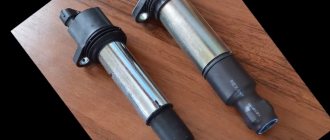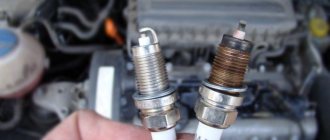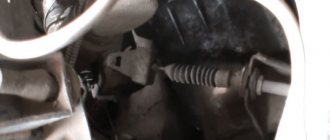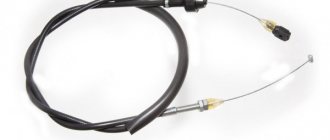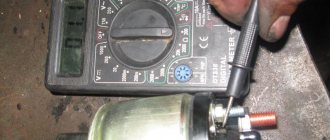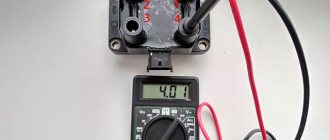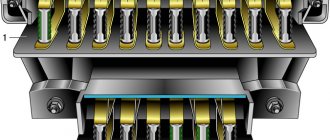The reasons why the spark disappears on a VAZ-2109 carburetor type car may be the following:
- faulty Hall sensor;
- the switch burned out;
- break in the ignition coil;
- high-voltage wires are worn out;
- the candles became unusable;
- The timing belt is worn.
From the very beginning, if the disappearance of the spark is detected, you should review all contacts and the condition of the electrical wiring. If you find oxidation on the connector, it must be cleaned with sandpaper and rechecked for the presence of a spark. High-voltage wires should be checked for integrity using a special device - a tester.
A breakdown in the ignition switch can be diagnosed using a standard automotive lamp. One of its contacts must be connected to the body body or carburetor engine 2109, and the second contact must be connected to wire “B+” from the ignition coil. If the light is on, this indicates that the ignition switch is working properly. In this case, you need to go to the ignition coil.
The serviceability of the Hall sensor can be checked using a voltmeter or, again, a light bulb. At the moment the distributor rotates, the filament in the light bulb should change the intensity of the glow.
Verification procedure
If you detect one or more signs of “dying” of the coil or if it is impossible to start the engine, you should definitely check its performance. This is necessary in order to find out what nature of the breakdown occurred, and, therefore, begin to eliminate it. Can this be done without instruments? Unfortunately no. Unless you immediately replace the coil with a known good one. At the very least, a regular multimeter will suffice. Such a tester must be kept in the car - its cost is almost symbolic.
In general, verification is relatively easy. It is enough to follow the steps described below, and even a completely inexperienced car enthusiast can handle it.
First of all, you need to inspect the ignition unit itself. If the engine does not start at all, then you need to find out if there is a spark. You need to do this:
- disconnect the main wire from the distributor (located in the center);
- connect a candle to it;
- holding it with pliers, apply it to the motor housing or to the breaker;
- turn on the ignition.
If there is no spark, there is only one conclusion - failure in the coil. Next, you need to find out whether electricity is supplied to it.
The check is carried out with a multimeter. One of its probes is applied to terminal “B” on the coil, the second to ground. If there is no voltage after turning on the ignition, the fault is looked for directly in the lock.
In addition, it is also possible to power the coil using an emergency circuit. Here the wire from the positive terminal of the battery is connected to contact “B”. In this situation, you can be absolutely sure that voltage is supplied. However, when these actions did not lead to a spark, you will have to test the primary winding for integrity.
- the wiring located on its sides is disconnected (they are low-voltage);
- the multimeter is set to Ohms and the resistance is measured;
- The secondary winding is also ringed in the same way.
Examination
If you notice signs of a problem with the ignition coil, or have to deal with a situation where the engine “died,” be sure to check the condition of this element.
As you test, you will be able to determine what caused the coil to fail and how the problems can be corrected.
How to check the device? The instructions are not complicated, even a beginner can handle it.
First, let's check the condition of the unit, and then check for correctness of the resistance of the coil itself.
- If the engine cannot be started, make sure that the coil itself is producing a spark at all. To do this, the central wire is removed from the distributor and a spare spark plug is connected to it.
- Now take the spark plug with pliers and place the metal casing on the breaker or motor.
- If a spark does not appear when the engine starter is turned, there is a malfunction in the ignition system.
- So check the power to the coil, or rather its presence. For this you will need a multimeter. One terminal is connected to contact B on the coil, and the second goes to ground. Turn on the ignition. If there is no voltage, the culprit is the ignition switch.
- You can start the engine in emergency mode. To do this, the plus from the battery is thrown onto contact B of the coil.
If there is voltage but there is no spark, check whether the primary winding is intact. To do this, the side low-voltage wires are disconnected from the coil and resistance measurements are taken with a multimeter. Then the secondary winding is checked.
We will tell you about this procedure in more detail.
Multimeter for testing
How does the Hall sensor and centrifugal mechanism work?
On a VAZ-2109 car, the distributor corrects the ignition timing during engine operation. This is possible due to the use of a centrifugal device in the design. It can affect the slider when the engine accelerates sharply. The centrifugal mechanism is similar in design to those devices that were installed on contact-type ignition systems. In addition, the breaker on the VAZ-2109 car is also equipped with a vacuum corrector. When a vacuum is created in the intake manifold, it is then transmitted through a special tube to the corrector chamber. There is a rubber diaphragm there. The latter is connected to a rod, which is fixed to the plate. This is where the Hall sensor is located. This element made it possible to remove the contact group from the distributor and make the operation of the ignition system more stable.
The Hall sensor, together with this plate, can move, thereby adjusting the ignition timing. In this case, the SOP increases or decreases. It depends on the number of revolutions and how intensely the engine picks them up.
Candles
In the carburetor VAZ 2109, spark plugs fail more often than other elements of the system. This is due to poor fuel quality, incorrect fuel supply settings, and the spark plugs themselves. In addition to the fact that there are a lot of fakes on the auto parts market, not every owner of a “Nine” bothers with the heat rating or the gaps between the electrodes provided for by the manufacturer’s recommendations. So it turns out that having bought seemingly new and branded spark plugs, we have an unstable idle or even tripping. In the future, these seemingly minor faults can lead to more serious problems.
Ignition of the VAZ 2109 requires four spark plugs: one per cylinder. They are checked one by one. First, one of them is unscrewed and visually inspected for the integrity of the ceramic insulator, the condition of the electrodes and the size of the gap between them. If, at first glance, everything is in order with the candle, you need to determine its performance. To do this, put a cap of a high-voltage wire on it and connect it to the ground with a skirt. Next, you need to attract an assistant and ask him to start the engine. When the starter begins to rotate the crankshaft, a steady blue or light blue spark should jump between the electrodes. If it has a different shade (red, greenish), this may indicate a possible breakdown of the insulator or an insufficiently high voltage. If there is no spark at all, most likely the spark plug has failed. But other faults cannot be ruled out here. This is why it is necessary to check all spark plugs. If only one of them does not work, try replacing it with a known working one. But if there is no spark on all the spark plugs, you need to look deeper for the problem.
Carburetor engine ignition system
All “nines” are equipped from the factory with a contactless ignition system. Structurally, it consists of the following elements:
- ignition switch;
- high voltage coils;
- switch;
- ignition distributor with Hall sensor;
- four high-voltage wires;
- spark plugs.
If any of the first four elements malfunction, the ignition system stops working and starting the engine becomes impossible. The situation can be corrected by diagnosing and repairing the breakdown.
No spark on an injection engine or an engine with a carburetor: how to check
Checking the spark is possible using several methods: to ground, using a multimeter, or a special tester on a piezoelectric element. The first method is the simplest. The body of the unscrewed spark plug is brought to the metal (usually the engine cylinder block), after which the engine is cranked by the starter and the presence of a spark is analyzed.
Please note that this verification method cannot be used when diagnosing injection cars. The fact is that a car with an injector has an ECU and other electrical equipment that is quite sensitive and can be damaged
The second method allows you to better assess the condition of the spark plug, identify breakdown, etc. The use of a special tester is a method of checking the spark on injector cars, reminiscent in its principle of checking by analyzing the spark breakdown to ground (the first method). In this case, the risk of burning the control unit is minimized. Now let's talk about how to check the spark on a fuel-injected engine.
As mentioned above, a special spark arrester device is used to check the spark on the injector. The presence of this solution during diagnostics allows you to accurately localize the problem area, since the ignition spark may not be on the spark plug, on the distributor or on the coil. Also, there may be no spark in only one, several or all cylinders of the engine.
A complete lack of sparking indicates possible problems with the controller, ignition module, coil or center wire. Diagnostics should begin by checking the fuses. Then you should evaluate the condition of the ground contact, and also check the high-voltage wires.
If there is no spark at the ignition coil, then the functionality of the high voltage wire should be checked. The specified wire must be checked for insulation integrity, have no breakdowns, burnt areas, etc. Detection of any defects is grounds for its replacement.
Also, in the process of diagnosing the ignition system, you should inspect the spark plugs. This must be done if electricity reaches the candles. On carburetor cars, it is enough to remove the spark plug wire, and then bring it closer to a metal surface (for example, a car body) by half a centimeter. Then you need to turn the starter and make sure that there is a spark running between the wire and the metal surface. The spark itself should also have a certain intensity, be white with a slight bluish tint. If no deviations are noticed, then the spark plugs are working. The reason that there is no spark at the spark plug may be the ignition coil.
If you notice problems with the spark plugs, then you need to pay attention to the spark plug contacts. These contacts must be free of contamination
Let us add that if deviations from the norm are noticed, it is optimal to immediately replace the spark plugs. Failure to do so will indicate the need to clean the contacts.
Distributor
After the coil has been checked and the diagnostic results show that it is in good working order, we move on to the ignition distributor (distributor). Disconnect the high-voltage wires from its cover and unscrew the two screws securing it. Remove the cover and inspect it for integrity. Pay attention to the condition of the carbon contacts and the distributor runner. If any malfunctions are found, the cover (assembly) will need to be replaced.
The Hall sensor serves to transmit control and correction pulses to the switch depending on the number of engine revolutions. It is installed inside the ignition distributor, but to check it, it is not necessary to disassemble this element. All you need is a car tester or a multimeter turned on in voltmeter mode, as well as a couple of pins.
Find the green and black and white wires in the connecting block connected to the distributor. These are the sensor terminals. On these wires you need to pierce the insulation with pins, and connect the probes of the measuring device to them. Have an assistant slowly turn the engine crankshaft by hand.
If the Hall sensor is working properly, when rotating the device will show voltage surges from 0.4 to 12 V. If it has become unusable, the device will be “silent”. In this case, repairs (VAZ 2109) will be limited to replacing the sensor.
Stage one
Usually the symptoms of difficulty are the following: the starter rotates regularly in its own standard mode, but the engine does not want to start. One of the most possible circumstances is a fuel pump that does not start. When on injection “tens” it is submersible and is located directly in the tank.
There is an option to check the element by the presence of operating sound. Turn on the ignition - there should be a rumble in the area of the rear seats. He is absent from time to time. In our version, you should check the fuses. The VAZ-2110 is a fuel-injected car, and the fuse box is located on the side of the center console of the unfamiliar front passenger. You need to unscrew the fasteners, then remove the cover, check the fuses for functionality and change them as necessary. In this case, the elements are 100% serviceable, then you need to check whether the relay will turn on, both the main one and the fuel pump. Of course, you can feel the moment of switching on with your finger. A corresponding click will also be heard.
If the fuel pump is operational, use a pressure gauge to check the presence of fuel there. If there is no pressure gauge, then press on the spool at the bottom of the fuel rail. myth element may be in a protective cap. The pressure will be completely tangible, although its power cannot be found. A running pump and no pressure indicates an obstruction in the fuel line. This is caused by a clogged fuel filter.
We set the ignition on a VAZ-21099 carburetor without a strobe
To set the ignition in the absence of a strobe, you must first loosen the distributor fastening so that it can be turned freely. At the same time, it should not dangle. After this, we start the engine and spin it at idle to maximum speed. After this, turn the distributor to minus one notch and turn off the engine. We tighten the fastening screws and proceed to adjusting the carburetor.
First, we tighten the fuel mixture quality control screw all the way, and then rotate it in the opposite direction by one-third of a full turn, which will correspond to an idle speed of 800 + 50 rpm.
How a spark is formed on a candle
By turning the key in the ignition, you turn the starter. Its function is to engage the gear with the flywheel to transmit torque to the flywheel. As soon as the parts are engaged, the moment is transferred - the key returns to its place. And during this time, while the key was turned, a number of processes should occur, as a result of which a spark appears on the candles.
The flywheel itself is mounted on the crankshaft and rotates it. From the crankshaft through the timing belt, rotational motion is transmitted to the camshaft. Simultaneously with the camshaft and at the same frequency, the shaft on which the distributor slider (ignition distributor) is located rotates. The cylindrical screen rotates and an electromagnetic field (EMF) is generated, the voltage value of which is read by a Hall sensor. Next, the switch comes into operation. This device converts the voltage to the required value and transmits it to the primary winding of the ignition coil.
An electromotive force is generated inside the coil and exits through the central electrode. From here the pulse is supplied to the central wire of the distributor, to which 4 spark plugs are connected. The distributor rotates, making contact with each of the spark plugs in turn. The spark plugs are screwed into the cylinder head, their electrodes are located in the combustion chamber.
As a result of a short circuit on the spark plugs, a voltage of 10–15 kV is achieved. This is enough for a spark to occur between the central and side electrodes of the spark plug.
The performance of the distributor and spark plugs
If everything is fine on the section of the circuit opposite the coil, the causes of the breakdown lie in the failure of the distributor or spark plugs. You should check the contacts of the distributor cover and the slider. All connections must be clean, free of black deposits, stains, dirt, moisture and oxidation. If there is such contamination, we clean it. If the integrity of the cover is damaged, it must be replaced.
Even if the distributor is working, there is still no spark on the VAZ 2109? It is necessary to check the condition of the spark plugs. A too rich working mixture in the combustion chamber causes damage to them. The spark plugs become covered with soot, which reduces current conductivity, and the contact between the electrodes deteriorates. It is necessary to clean the spark plugs with a wire brush and adjust the gasoline supply to the carburetor.
Candles can also be "flooded". This happens when, with the air damper closed (on choke), you try to start the engine several times to no avail. In this case, it is necessary to dry the candles over the fire.
If there is no spark: ignition module
The following symptoms indicate possible problems with the operation of the ignition module:
- at idle speed the engine troits;
- power decreases, the car accelerates poorly;
Engine vibration is most pronounced in two nearby cylinders, and the drop in thrust is more strongly felt during attempts to sharply accelerate the vehicle, that is, when the accelerator is pressed hard and sharply. In such a situation, the “check” light usually lights up on the dashboard of most cars.
If checking the spark plugs and high-voltage wires does not reveal any problems, then the ignition module should be checked with a tester. The test consists of connecting one output of the tester to the module connector, and powering the other to ground. Then the engine can be started. A tester reading of 12 V is evidence that the module is OK. A deviation in the instrument readings from the norm may indicate either the need to replace the module itself or to check/replace the corresponding fuses.
https://youtube.com/watch?v=ZFJTiLZWSu0
Device Features
The ignition coil serves to produce a spark coming from the spark plug electrodes. To put it briefly and simply, this is a small transformer that operates in pulse mode and converts 12 volts from the car into 20-30 thousand volts at the output. High-voltage wires are used to transmit the impulse, which also sometimes cause coil malfunctions.
The distributor-type ignition system works simply - the distributor (distributor) receives a low-voltage pulse from the car's network, transmits it to the coil, and it, in turn, transforms the pulse into a high-voltage pulse. Next, the distributor distributes sparks among the cylinders depending on the order of their operation.
Structurally, the VAZ 2109 coil consists of a pair of windings - secondary and primary.
- The primary winding has fewer turns, but wires with a larger cross-section;
- The secondary winding of a coil with a large number of turns, but a smaller wire cross-section.
Windings
Signs of breakdown
Often the spark at the carburetor disappears unexpectedly when the driver is not prepared for such a turn of events. But if you have enough experience and pay close attention to the behavior of your car, you can detect signs of a malfunction before the spark disappears and the engine does not start.
In search of a spark: candles
If there is still voltage on the central high-voltage wire, it is necessary to determine whether it is distributed and supplied to the spark plugs. To do this, you need to determine whether the distributor and Hall sensor are in working order, whether the high-voltage wires are broken and whether the spark plugs are working. Let's start from the end.
Unscrew the first spark plug, place it on the valve cover without disconnecting the high-voltage wire from it, but disconnecting it from the other spark plugs, and ask an assistant to try to start the engine with the starter. Visually determine if a spark appears between the electrodes. If there is one, screw the spark plug back in and repeat the procedure for each individual cylinder. Be aware of the risk of electric shock, use pliers!
View gallery
If there is no spark on the VAZ 2109 spark plugs (carburetor), try installing new ones or known good ones instead. The situation has not changed? We continue diagnostics.
No spark VAZ 2109 carburetor reasons
The carburetor "nine" does not produce a spark. Why does this happen and what to do? If there is no spark in the VAZ 2109 carburetor, the reasons lie either in the malfunction of one of the elements or in the wiring that connects them. You can independently identify the cause of the unit failure. To troubleshoot, you will need an assistant to turn on the ignition. You will need a multimeter, as well as spare parts (switch, Hall sensor). To find a breakdown, you need to understand the sequence of connecting the circuit elements and at least in general know the principle of the appearance of a spark on the spark plugs. Let's look at it and check all the devices for functionality.
High voltage wires
It doesn’t often happen that all the wires fail at once, but they still need to be checked. The functionality is determined by disconnecting each one in turn and measuring the resistance. In good condition, the resistance value, including on the main conductor, should be within the range of 2.7-9 kOhm. If deviations are detected, faulty elements must be replaced.
It will not be superfluous to check the so-called “coal”, that is, the graphite contact of the wire. If it is damaged, no voltage is supplied to the slider and all spark plugs will be de-energized.
Based on the list of common problems that cause the “nine” to lose spark, it is clear that this car is not very complex in terms of effort and time. It is enough to have a basic set of knowledge and a set of tools - and the car is ready to travel again.
The candles are flooded in the cold, what should I do?
If you still couldn’t avoid an unpleasant situation, don’t panic, everything can be solved!
Method No. 1, or what the manufacturer advises
- Unscrew the wet spark plugs from the injector.
- Dry them.
- Crank the starter for 10-15 seconds, only then install the dismantled parts in place and start the engine.
Method number 2 - logical
- Remove the car battery and charge it.
- Unscrew the jammed ignition elements and install new ones in their place.
- Return the battery to its place and you are ready to go to your destination.
Method No. 3 – folk-practical
- Press the gas pedal all the way to the floor and crank the engine with the starter for 10-12 seconds.
- Release the gas pedal. The engine should start.
Method No. 4 - the old “grandfather’s”
- Unscrew the gasoline-soaked spark plugs and use an old toothbrush or metal brush to thoroughly clean them of carbon deposits and other contaminants.
- Dry the cleaned parts well: with a hairdryer, on the stove, on a radiator or in the oven.
- Check the gaps and, if everything is in order, install everything in its place.
And so that the problem does not bother you anymore, make it a habit to ALWAYS:
- refuel only with high-quality fuel;
- fill your vehicle only with good motor oil with appropriate parameters for the cold season;
- monitor the battery charge and the serviceability of the starter and high voltage wires;
- clean and adjust injector nozzles in a timely manner;
- purchase spare parts, including spark plugs, only from trusted manufacturers with a good reputation.
The simplest way to check for proper ignition of carburetor VAZ-2109
If there is no spark in the car, you can find the reasons in another way. This technique does not require the use of a special device or tool. In this method, the entire ignition chain is tested, without taking into account the Hall sensor. To carry out this work, we need a small wire with insulated ends and a nail or paper clip.
First of all, we disconnect the high-voltage cable from the distributor. During checking, it must be positioned approximately 10 millimeters from the minus of the car. Next, turn on the ignition. Disconnect the connector from the Hall sensor and connect its end to the middle contact, to which the green wire is connected. We short the other end of our wire several times to ground. At the moment of short circuit, sparks should run between the ground and the end of the wire. If there is a spark in a carburetor VAZ-2109, we can conclude that the Hall sensor is faulty or there is no contact. Often, inside the distributor itself, the plate frays the wires or the connector simply becomes loose. In addition, there are cases when, when checking, we see the presence of a spark, but when connecting the wire to the spark plug caps, there is no spark. This indicates the need to replace the slider inside the distributor. Some carburetor-type VAZ-2109 are equipped with an ignition interlock circuit, which may also become unusable (or there is a malfunction in the switch).
Before performing the test, you need to prepare the following set of tools:
- figured and flat screwdrivers;
- insulated pliers;
- control with a wire or tester;
- spare spark plug.
To protect yourself from electric shock, you should wear dielectric gloves.
Verification process:
- We turn off the ignition, after which we check the high-voltage wires for breaks, and at the same time check for good contact in the connections with the distributor and the ignition coil.
- We carefully inspect the condition of the wires between the distributor and the switch, and also check the wires from the ignition coil to the switch.
- With the ignition switch on on a carburetor VAZ-2109, you need to check the presence of power in the system. To do this, take a test lamp, connect one end to ground, and the other to the “B+” contact of the coil. The glow of the control lamp indicates the presence of power.
- Using a rubber glove, disconnect the middle high-voltage wire from the distributor. We put a spark plug into its tip and touch the engine ground with the metal part. When cranking the starter, sparks should flow from the spark plug.
- Unscrew the screws of the distributor and remove its cover. We check for cracks and damage, and also check the condition of the coal. If the cover is damaged or cracked, it must be replaced.
- We inspect the condition of the slider in the distributor. Quite often it happens when there is no spark due to a breakdown of the interference suppression relay or breakdowns in the housing of the ground slider.
- We check the crankshaft by rotating the starter. If the slider is stationary, the reason for this is a broken timing belt or the drive itself is faulty.
- We check again for the presence of a spark.
- If once again there is no spark in a VAZ-2109 carburetor type car, you should check the high-voltage ignition wiring, as well as the spark plugs themselves. To do this, you must use a known good spark plug. If there is still no spark, change the high-voltage wire.
A car may not start for a variety of reasons. One of the reasons may be the lack of a spark in the ignition system. Moreover, this problem occurs more often in carburetor cars than in injection cars. VAZ 2109 is no exception to this rule. We will talk about why the spark on the carburetor disappears and how to deal with it in this article.
The main reasons for the lack of ignition
The principle of operation is clear. All malfunctions of the VAZ 2109 ignition system are associated with the failure of one of the above elements. If there is no spark on the VAZ 2109 carburetor, it means there is a malfunction:
- switch;
- Hall sensor;
- timing belt;
- ignition coils;
- ignition switch contact groups;
- distributor cover contacts;
- candles (“drenched”, burnt);
- circuit wiring.
If the commutator is faulty, then the voltage value to the coil is not converted. A failed Hall sensor does not supply current to the switch. If the timing belt breaks, the operation of the system is disrupted and EMF is not generated. A broken coil stops the chain moving on itself, the distributor contact does not receive voltage. Damaged distributor cover contacts prevent voltage from being applied to the spark plug.
The spark plug electrodes may not produce a spark due to carbon deposits or moisture on them. It happens that the culprit is the first element of the circuit: the ignition switch. A breakdown in its contact group does not start the starter. It is also possible that a banal damage to the wiring has occurred, causing the connection of the elements to disappear.
If there is no spark in the VAZ 2109 injector, the process of finding a breakdown is much more difficult. After all, the design of the system requires the presence of a separate ignition module controlled by the ECU.

